Many people today claim to use some form of alternative medicine or complementary therapy to manage their health.
In recent years, doctors and researchers have begun to include complementary and integrative approaches to medicine in their research to understand how alternative medicine is being used today.
According to the National Center For Complementary and Integrative Health, Of those who use complementary or alternative medicine techniques, women are slightly more likely than men to use these techniques, and as income and education levels rise, so do the uses of these techniques. At least 40% of people in their 40s, 50s, and 60s are using some form of a complementary or alternative approach for their health or wellness.
Use of complementary and alternative medicine is greatest among those of American Indian or Alaska Natives decent (50.3%), followed by whites (43.1%) and Asians (39.9%). Blacks and Hispanics are less likely to use these approaches (25.5 and 23.7% respectively).
When asked which complementary or alternative therapies they used, the most common responses included nonvitamin/nonmineral natural products, deep breathing, and meditation. Among the top listed were also chiropractic care, massage, yoga, diet-based therapies, progressive relaxation, guided imagery, and homeopathy.
Many people report using natural products, which includes nutritional supplements and herbal remedies. The most popular of these in 2007 was fish oil supplements, and others high on the list include flaxseed, ginseng, and garlic.
People choose complementary or alternative medicine to address a number of health issues. Musculoskeletal problems, including back, neck, joint pain, and arthritis, are generally high on this list. Rounding out this list for uses of alternative medicines includes anxiety, high cholesterol, congestion, headache, and insomnia.
Grandview Research reports that “the global complementary and alternative medicine market size was valued at USD 52.00 billion in 2017.”
Alternative therapies are used because they represent a different approach to healing, one that often focuses on balance, holistic healing, and restoring the body’s natural energy. The most significant benefit of this form of healing is that is attempts to allow the body to heal itself while introducing therapies that will enable this to happen.
Most who seek alternative treatments do so to treat the whole body and to address root causes rather than merely mask symptoms.
Most people today see many different doctors who specialize in specific systems or diseases, and many long for an approach to health and healing that treats them as people with issues that may be interconnected. Most forms of alternative medicine focus on treating the whole person, not the illness.
Most alternative medical practitioners also spend more time with their clients or patients, which can be a welcome change from the typical doctor’s office visit these days.
Personalized medicine means you can get a treatment plan based on your individual needs, and many people today appreciate the attention to wellness and overall health that alternative practitioners provide.
The significant benefit to alternative medicine is its focus on prevention.
While most conventional doctors only see you when there is a problem, your holistic medical professional will encourage you to come when you are well, too. Prevention of disease is just as important as treatment, and alternative practitioners know this.
The key to selecting the right alternative medicine or complementary therapy for you, or for looking for an integrative approach to healing, is to consider balance, your own priorities, and what you believe to be best for you
Acupressure

Chi can release tension and improve blood flow. Using acupressure therapy is used to relieve pain, relax muscles, and enhance circulation. It can be applied to your own body or by a massage therapist or other practitioner of manipulative therapy. Acupressure can be used to help treat motion sickness, headaches, back pain, fibromyalgia, neck pain, and chronic fatigue. This form of alternative medicine is also used to treat many types of sexual dysfunctions and to enhance fertility.
Acupuncture
According to the Women’s Health Research Institute at Northwestern University, “At least 3 million adults nationwide use acupuncture every year.” Further, “many well-designed studies have found that acupuncture can help with certain conditions, such as back pain, knee pain, headaches, and osteoarthritis.
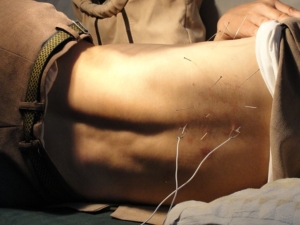
Acupuncture is used in Traditional Chinese Medicine to treat, prevent, and even diagnose health problems. The needles, when placed in precise locations on the body, release your natural energy, which can help improve various ailments and conditions.
The goal of acupuncture is to restore the balance of your chi or energy flowing through your body. The benefits of this release of energy include all types of pain relief and the treatment of many physical and emotional disorders.
The Evidence-Based Acupuncture Project reports evidence of positive effects of acupuncture on the following conditions
· Allergic rhinitis
· Chemotherapy-induced nausea and vomiting
· Chronic lower back pain
· Headaches
· Migraine prevention
· Knee osteoarthritis
· Postoperative pain, nausea, and vomiting
And evidence of ‘potential positive effect’ for more than 40 conditions including but not limited to
· Anxiety
· Acute stroke
· Asthma in adults
· Cancer pain
· Depression
· Hypertension
· Obesity
· Sciatica
· Insomnia
· Irritable Bowel Syndrome
· Menopausal hot flashes
· Shoulder pain
· Smoking cessation
· PTSD
· And many more
It is important to look for a qualified and licensed acupuncturist who runs a clean office. Whenever possible get a recommendation from your physician.
Alexander Technique
The Alexander Technique is a method whose purpose is to correct core posture that can cause many physical problems. The Technique educates its user about the importance of head, neck, and back alignment as well as proper posturing techniques.
Followers learn movement and poses that properly align muscles and unlearn poor habits of sitting, standing, and moving. Proper posture releases tension and remedies many medical issues.
Many who use the Alexander Technique are dancers, actors, and musicians, but anyone with chronic pain, muscle strain, headaches, or constant tension can receive help from this method.
When you learn to breathe differently and move your body for optimum posture, you will see improvement in your upper body in many ways. As you learn new habits and unlearn bad ones, you will practice breathing, walking, and engaging in everyday activities in new ways.
Autogenic Training
Autogenic training is a form of relaxation alternative medicine that is used to reduce anxiety. It is especially helpful when addressing social anxiety disorder, which is also known as SAD. As a part of cognitive-behavioral therapy or used at home by the individual, autogenic training mimics the relaxed state many people experience while under hypnosis.
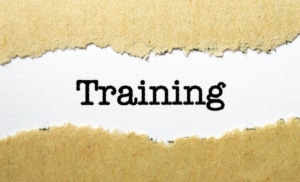
Users repeat various statements to themselves and engage in a process that brings warmth and heaviness to their bodies, which induces relaxation and reduces anxiety.
This form of relaxation is highly effective for treating anxiety, especially social anxiety. It can also reduce stress and promote calm, which can be helpful for those with sleeping disorders, mood issues, or other mental health challenges.
Ayurveda
Ayurveda healers believe in the connection between a person and the earth as well as the interconnectedness of all the universe’s elements- water, fire, air, space, and earth.
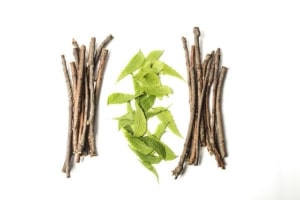
Ayurveda seeks to teach you to balance your doshas and to eat and live properly to maximize your health in order to live in harmony with the forces of the universe. Ayurvedic treatment is individualized to each person and its goal is to cleanse the body and restore harmony and balance. Practitioners will use techniques including massage, medicinal herbs, blood purification, enemas, and laxatives.
Chiropractic Medicine
Chiropractic medicine involves the hands-on manipulation of the musculoskeletal structure, as well as other alternative treatments, to properly align the body and treat pain and other problems.
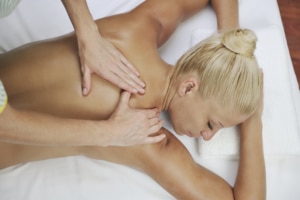
The most common and important benefit of chiropractic medicine is pain relief from injury, repetitive movement, or trauma. Chiropractic care can also be used to treat headaches, neck pain, fibromyalgia, and osteoarthritis.
Cupping
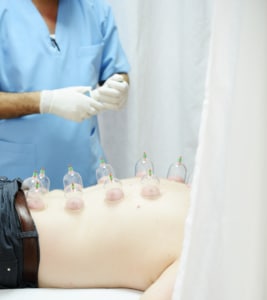
Cupping is a technique that is used in Traditional Chinese Medicine. Special cups are filled with heated air, then placed on painful areas of the body. As the air inside cools and shrinks, a suction is created under the cup, increasing blood flow to this area.
This increased circulation can help with inflammation, pain, and other problems. Cupping is usually done by a trained acupuncturist.
This technique has been used for at least 2,500 years to treat respiratory ailments, pains, and aches. It also can relieve coughing, treat menstrual symptoms, and improve circulation. Once the cups are removed, a bruise often remains, and sessions are repeated once these marks disappear.
Ear Candling
Ear candling utilizes a hollow tube inserted into the ear, then heated. The tube, called the candle, is made from fibers, usually hemp or cotton. It is sometimes coated with beeswax. When a flame is applied to the end of the tub, the heat that is produced soothes and massages the ear, loosens compacted ear wax, and supplies relaxation.
Some people experience relief from earaches, sinus trouble, and headaches from this therapy. It is a very relaxing technique, so it can bring relief from tension or stress, as well. Candling does not remove excess ear wax but can loosen it so your body’s natural processes can expel it.
Herbalism
Also known as phytotherapy, herbalism is the use of plants to address ailments and to promote wellness. This type of medical practice has been around nearly as long as man, and almost four-fifths of the planet still rely on herbal remedies and medicine to treat some or all their diseases.

In fact, half of all prescription drugs contain ingredients derived directly from plants, and our current medical knowledge is based on a foundation of herbal medicine.
Herbalism utilizes the natural compounds found in plants to treat illnesses non-invasively and non-aggressively. Herbs, which can include the roots, stems, flowers, and other plant parts, allow your body’s natural processes to work more efficiently, enabling you to heal yourself. Herbalism prefers to approach healing from a holistic standpoint and will focus on all aspects of wellness.
Herbalism can be used to treat any number of ailments, disorders, and conditions. A trained herbalist will tailor a specific treatment plan for your needs.
Homeopathy
Homeopathy, which is also called homeopathic alternative medicine, is a system of alternative medicine that uses small doses of various medicines to treat a wide range of illnesses. Homeopathy is based on three important principles.
The first is the law of similars, which says that a cure will create symptoms similar to the ailment. The next is the principle of a single remedy, which means that one medicine should cover all the problems you are experiencing. The final is the principle of the minimum dose. This includes giving medicine in small doses, and dosage should start very small until it is clear the effect it has on the symptoms.
Homeopathic medicines are made from plant, animal, mineral, and synthetic substances, and they are diluted to create very weak concentrations. These homeopathic therapies are used to treat skin conditions, pain, digestive disorders, and other ailments. Some chronic but not serious conditions, like ear infections, can also receive help from homeopathy.
Hypnosis
Hypnosis, which is known as hypnotherapy or trance work, involves techniques to foster healing through a stronger body-mind connection. A trance, in which you are in an altered state of conscious, can increase your awareness and help you receive suggestions to alter your state and promote better health. You must choose to enter a hypnotic state, and while you can use a therapist to guide you, self-hypnosis is also possible.
During a trance, suggestions are offered which can help remove any psychological obstacles and strengthen your sense of self, which can help you change your behavior. Hypnosis can be used to treat a wide variety of ailments and problems.
Hypnosis can help with gastrointestinal disorders, skin problems, and any disorder that is caused by or made worse by stress. Other uses for hypnosis include weight loss, smoking cessation, and any other issue where willpower and motivation are needed for success. Hypnosis can help with sleeping disorders, autoimmune diseases, and anxiety.
Magnet Therapy
Magnet therapy utilizes magnets placed on the body to treat disease and reduce pain. This form of alternative medicine includes magnetic field therapy as well as bioenergy therapy. Magnets of varying strengths are placed or worn on the body, used inside braces, or held to the body using adhesive patches, and the magnetic fields are said to stimulate cell activity. The influence of magnets on cells can improve circulation, enhance oxygen levels, and promote healing.
Conditions that are most often treated with magnet therapy include circulatory problems, inflammatory disorders, nerve disorders like diabetic neuropathy, insomnia, several types of pain, stress, and fibromyalgia.
Manipulative Therapy
Manipulative Therapy, also known as Osteopathic Manipulative Treatment (OMT), involves a hands-on technique for diagnosis, treatment, and prevention of disease and injury. Manipulative therapy is usually performed by an osteopathic physician (DO) and involves moving joints and muscles on the body as well as stretching and applying pressure to the body.
The goal of OMT is to understand the connection between muscles, bones, and nerves and how these influence various systems and processes.
Manipulative therapy is safe for use with people of all ages, and it can reduce the need for certain medications or procedures in many cases. It is often used to treat carpal tunnel syndrome, migraines, menstrual pain, asthma, or to treat any number of alignment and structural issues with your musculoskeletal system.
Meditative Movement
Meditative movement includes any type of meditation that involves moving. There are many different techniques that are classified as moving meditation, including Tai Chi, yoga, and Qi gong. If you apply mindfulness principles and the right pace, just about any movement can be made meditative, though.
This form of meditation is an excellent alternative for those who prefer a more active way to meditate. Meditative movement provides a release of tension and increased blood flow while also engaging in mindful thought.
In general, meditative movement involves paying attention to your actions as well as the flow of energy through your body.
You focus your attention on either a particular part of your body, such as your feet or your body as a whole. Movements are kept slow to help with focus and attention, and you still are focused on your action and its effect on your body throughout the practice.
The goal of the meditative movement is to focus your mind and attention, to become more mindful, and to move beyond your own mind to experience your essential nature. Doing so can promote happiness and peace, reduce stress, help you become more aware of yourself, others, and your life, and enjoy your life more. The meditative movement also helps you stay connected to your body’s needs, which can lead to improved health overall.
Meridians
As discussed previously, meridians are commonly used in Traditional Chinese Medicine (TCM), as well as other, ancient medicinal practices. They are specific channels or pathways within your body that move and release energy. Your chi, or vital life energy, flows through these meridians. Blocking your chi can cause illness or pain.
Acupressure and acupuncture, as well as other techniques, use points along these meridians. Pressure, needles, or other stimulation is applied to these points to rebalance and correct your flow of chi. Within TCM, there are over 300 points found on the various meridians in the body.
Practitioners of TCM have identified 12 regular meridians, each of which corresponding to an organ and run through the body to either foot or hand.
The heart, lungs, spleen, liver, and kidneys are called yin organs and are linked to a yin meridian, while the intestines, stomach, bladder, and gallbladder are yang organs connected to a yang meridian.
The meridians carry energy in a specific path throughout your body and understanding your ailment will allow the activation of various points along these meridians to encourage energy flow, which links to your health and ability to heal.
Mind-body Practices
Mind-body practices incorporate the use of the mind with movement to yield many different benefits for mind, body, and spirit.
Tai Chi
Tai chi is a form of meditative movement. It originated in China, and while there are several unique styles of practice, they all have the same guiding principles. These include integrating the body with the mind, controlling your movements and breath, creating internal energy, being mindful, loosening your body, and seeking serenity.
The movements of tai chi are performed to cultivate your chi and allow it to flow smoothly and powerfully through yourself.
Tai chi builds muscle strength, boost your immunity, improves your flexibility, and relieves pain while reducing stress. The meditative movements teach you to focus and attention, provide emotional tranquility, and connect you to your spirit.
Yoga
According to the National Center For Complementary and Integrative Health, “Yoga was the most commonly used complementary health approach among U.S. adults in 2012 (9.5%).” Heart.gov reports that 21 million adults and more than 1.5 million children practice yoga.
Yoga has come to mean many things in today’s world, but it essentially a meditative movement that promotes a connection between the mind, body, and spirit.
The techniques of yoga were introduced in India over 5,000 years ago, and it is a system of philosophy and practice that is designed to promote peace of mind, mental clarity, and spiritual growth as well as physical wellness.
The techniques of yoga are meant to guide your life for better living. They take an intense study to understand fully, so a simple weekly yoga practice is not enough to fully grasps its nuances.
However, using yoga techniques like Hatha yoga can help you relax, become more mindful, and connect with your health and wellness.
Yoga is not just something you do with your body; it is a way to greatly improve health and wellness on many levels.
· Stress management
· Calms the mind and body
· Lowers blood pressure
· Lowers pulse rate making the heart work more efficiently
· Improves blood oxygenation
· Improves blood circulation, which improves cognitive function and memory
· Lung health
· Digestive health
· Reduces anxiety
· Stronger immunity
· Pain management, including, chronic back pain, fibromyalgia, and arthritis
· Stimulates the body’s detoxification process that may delay aging
· Improves posture and flexibility
· Good for muscle health
· Heart health
· Builds strength
· Improved balance and stability
· Improved body awareness through the mind-body connection
· Stronger core
· Improved body control
· Relaxation of mind and body
· Evidence finds yoga may lower blood glucose levels
· Better life quality, the improved mood for sufferers of chronic diseases, such as heart disease
· Improved cardiovascular health
Conditions/Diseases Helped By Yoga
· Carpal tunnel syndrome
· Menopause symptoms
· Back pain
· Asthma
· Cancer treatment side-effects
· Migraines
· Obsessive-compulsive disorder
Qi Gong
Qi gong, also known as qigong and chi kung, is a type of meditative movement aimed at improving your mental and physical health. It does this by integrating movement with posture, breathing, sound, focused intent, and self-massage.
There are many ways to practice qi gong, including many traditions and lineages. The purpose of the practice is to open the flow of energy in your meridians, enhancing your ability to feel and experience your life force as well as the forces of the universe. It is a series of slow, gentle movements that warms and tones tissues, promotes circulation, and helps you attend to your needs.
Qi gong is a meditative movement technique that can be used by anyone wishing to practice mindfulness, reduce stress, or become more connected to their body. The various paths of qi gong can be used for personal cultivation and to enhance well-being.
Naturopathy
Naturopathy is a system of treating someone using diet, exercise and other natural approaches and eschewing medications and prescription drugs. Naturopaths use natural therapies to allow the body to heal itself. This form of alternative medicine treats the whole person and focuses on healing the cause of any illness, not just addressing symptoms.
A visit with a naturopath could take up to two hours, as the practitioner examines you, asks questions, and tries to understand your lifestyle.
Education and prevention are two main goals of naturopathic alternative medicine, with a focus on nutrition, exercise, stress management, and lifestyle choices related to your overall health and well-being.
Naturopaths use many different treatment options, including herbal alternative medicine, acupuncture, touch therapy, and other alternative approaches, to address problems in your health. Naturopathy is used to treat all types of disorders and illness as well as promote overall health and well-being.
Neuro-Linguistic Programming (NLP)
Neuro-linguistic programming (NLP) is a technique that teaches you to learn and carry out new tasks by analyzing successful people and applying their techniques to your life. The principle behind this therapy is that, if you can understand how someone else accomplishes something, you can learn and copy their technique, giving you a chance to be successful, too.
The technique can be used to learn the language, patterns of behavior, mindsets, or anything that can be experienced. The purpose of NLP is to learn a systematic approach to learning and experiencing life so that you can always be getting feedback and setting new goals for yourself.
This technique is popular as an approach to helping those in business, the performing arts, sports, and alternative medicine, where you want to learn from the success of others and continue to refine your practice over time.
Therapists who use NLP methods try to understand the behavioral and thinking patterns of patients, then recommend new behaviors that would replace unproductive ones. NLP can help people with different mental health conditions, including depression, PTSD, panic disorders, phobias, and addiction.
Nutritional Healing
Nutritional healing is a therapy that uses supplements, herbs, and food to treat various disorders and ailments. By maximizing the nutritional powers of plants, vegetables, fruits, and other foods, you can help your body heal itself. In addition to eating certain foods, this form of healing also uses fasting or abstinence from specific foods, as well as topical applications of certain foods, to address various issues.
Strategic eating and managing your diet are believed to reverse many physical ailments, including cardiovascular disease, inflammatory disorders, and respiratory diseases. Even symptoms of certain mental health conditions can be mitigated by the right nutrition.
Nutritional healing is also helpful for limiting symptoms from certain chronic diseases like Celiac disease and diabetes. Healthy nutrition can also help boost your immune system and allow you to fight off other conditions and diseases.
Nutritional Supplements
Nutritional supplements, also known as dietary supplements, are manufactured products that supplement various nutrients that may be missing from your diet.
Supplements can be in the form of powder, tablet, capsule, or liquid, and these are meant to provide you with essential nutrients that are otherwise missing or too low in the foods you normally consume.
Supplements may provide you with amino acids, fatty acids, fiber, minerals, vitamins, or a combination of these.
Nutritional supplements are generally considered inferior to natural foods but preferred to nutritional deficiencies. Not only are they effective for those whose diets may lack specific compounds, but they are also necessary for people with certain diseases or disorders.
Pregnant women, the elderly, and those with a poor appetite due to medical problems may need supplements to get all they need for optimal health. If you have food allergies or follow a specific elimination diet, such as veganism, you may lack specific nutrients in your diet.
Osteopathic Medicine
Osteopathic medicine is a type of healing that is patient-focused and deals with all aspects of patient care, including spiritual, mental, and physical well-being. Practitioners focus on wellness and treat problems holistically. Osteopathic care addresses the relationship of organs and systems to muscles and bones as well as the mind.
This form of alternative medicine is preferred by those who wish to focus on preventative care, holistic healing, and treating the cause of disorders, not just the symptoms. While osteopathic practitioners use some conventional medical techniques, they also rely on some more alternative choices, as well.
Polarity Therapy
Polarity therapy, based on the principles of attraction and union of opposites across a middle point, stimulates and balances the flow of energy within the body. Your body is an energy system, similar to a magnet.
You have positive and negative currents that flow through your body as well as poles that anchor your energy. Polarity therapy works to focus the flow of your chi, or life energy. The flow of this energy leads to better health and overall well-being.
Polarity Therapy is a combination of techniques, including counseling, nutrition, exercise, and bodywork to help you achieve optimal health. The emphasis on this form of therapy is on self-responsibility.
Psychic Surgery
Psychic surgery is the channeling of spirit surgeons to perform the removal of physical and emotional damage from the body. No incision is made by the psychic surgeon. Instead, the spirit surgeon enters the body to remove diseased tissue or heal emotional wounds.
Shiatsu
Shiatsu, the Japanese word for finger pressure, is a type of bodywork similar to acupressure. Shiatsu is often used to describe a type of massage, but it can be used in other applications. The finger pressure of shiatsu releases your chi (ki), disrupting disease and restoring health.
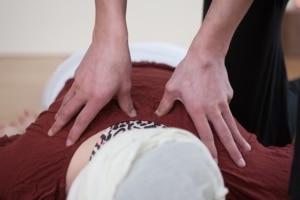
Shiatsu not only lifts your mood, but it can also be used to help you relax, deal with emotional or mental health issues, and address other aspects of your physical health. This technique is used to treat sleeping disorders, lack of appetite, pain, and mood disorders. Because it relaxes you, shiatsu can also help reduce inflammation and stress-related health problems.
Structural Integration
Structural Integration, a form of bodywork, focuses specifically on the fascia, or connective tissues, that is inside your body. Fascia can be found surrounding all your nerves, organs, blood vessels, individual muscles, and groups of muscle. It binds these things together while still allowing movement.
While fascia should be elastic and move freely, it can become tight and dense over time, due to strain, injury, and repetitive motion. When it loses its elasticity, it pulls your frame out of alignment, causes pain and inflammation, and leads to fatigue.
By lengthening, stretching, and softening these tissues, Structural Integration seeks to restore movement, enhance blood flow, and improve your posture. This alternative medicine can reduce pain, promote relaxation, and treat many inflammatory disorders.
Support Groups
Support groups are a form of talk therapy that involves groups of people coming together regularly to discuss shared experiences or get help with similar problems.
Participants receive advice, support, and encouragement, which can be helpful in addressing the psychological and emotional aspects of healing.

Support groups are beneficial for receiving acceptance, encouragement, and understanding about a particular problem. Sharing stories and expressing emotions can allow you to work through feelings from traumatic events.
By helping others in the group, you also gain a sense of pride and control. Participants often feel less stressed and more able to cope with their problems, which can lead to overall improved wellness.
Traditional Chinese Medicine
Traditional Chinese Medicine (TCM) is a system of healing and wellness developed in China many centuries ago. The guiding principles of TCM include supporting good and getting rid of evil, which includes how you treat your health.
The goal of TCM is to promote health by strengthening your body’s natural systems and defenses. Practitioners focus on how your body interacts with and is affected by the world in which we live, and it nurtures the mind, body, spirit connection.
As previously mentioned, chi (qi) is the life energy of the body, and TCM uses techniques to unlock and use that chi to achieve wellness. TCM has many techniques, including acupuncture, cupping, moxibustion, herbal medicine, and nutrition, to promote wellness and prevent disease. Traditional Chinese Medicine focuses on balance and energy to create harmony and wellness both within and with others.
Traditional Japanese Medicine
Kampo is the name of Traditional Japanese medicine, which is essentially the study and practice of TCM in Japan. Since its introduction in Japan, though, TCM has been modified to include unique systems and techniques for diagnosis and treatment. Modern Kampo uses many of the traditional techniques of TCM but has a heavy emphasis on herbal medicines.
Traditional Korean Medicine
Korean medicine is that country’s application and adaptation of TCM. In Korea, traditional medicine uses about 80 percent of the techniques used in China and Japan, but Korean medicine differs in a few ways.
The administration of herbal medicines and acupuncture treatments is different, with greater emphasis on individualization rather than standardization of treatment. Herbal treatments use less medicine than in TCM but more than is used in Japan.
Traditional Tibetan Medicine
Traditional Tibetan Medicine may be the foundation of all other eastern traditions and originated in the Himalayas. It has since migrated not only to the rest of China, Japan, and Korea but also to influence traditions in Russia, India, Europe, and North America.
Tibetan alternative medicine predates Buddhism in that country, but over the centuries, it has evolved to include aspects of TCM, Ayurveda, and Persian medicine.
Tibetan medicine focuses more on the universal elements of space, air, fire, water, and earth than other Asian traditions. Illness is believed to be the result of mental poisons aversion, attachment, and ignorance. Most treatments involve diet and lifestyle changes, herbal medicines, and body manipulations.
Urine Therapy
Urine therapy, also known as autotherapy, utilizes your own urine to treat various illnesses. This alternative medicine originated in India and has been used to treat many different conditions, including cancer.
Urine therapy involves either drinking one’s own urine or applying it to the gums or skin. After you excrete it, urine is sterile and contains not only mostly water but also minerals, salts, enzymes, and hormones which can benefit your health.
Urine therapy is believed to boost immunity, prevent allergies, improve your heart health, prevent viral infections, and treat skin conditions such as acne. It has also been used to treat cold sores, arthritis, and even leprosy.
Zang-Fu Theory
Zang-fu theory is an aspect of TCM, which emphasizes a holistic understanding of how the body functions. Practitioners of zang-fu then apply techniques to treat the interactions between organs and how these influences your health.
Rather than identifying organs as the individual components of your body, this alternative medicine instead divides your entire body up into twelve organs, six zang, and six fu organs. When diagnosing problems, this theory looks for external signs to reveal what is happening internally, so that it can be addressed.
Because this theory was created before our anatomical understanding of the human body was fully known, the “organs” of zang-fu theory do not match what we think of today, but this way of thinking about the body yields a more holistic and integrated look at how our bodies perform and how various systems work together.
Final Thoughts
As you can now see, there is a wide range of alternative medicine techniques, traditions, and therapies that can be used in place of or to complement more conventional methods of healing. Alternative medicine is focused on prevention as well as seeking balance in one’s life and health. The techniques often promote your body’s own ability to heal itself.
Alternative medicine therapies emphasize holistic approaches to wellness, recognizing that mental, physical, and emotional health all influence one another.
The philosophical and spiritual beliefs and principles that guide these healing methods can help you better understand their applications and their possible uses.
Choosing alternative medicine over conventional therapies, or complementing your conventional treatment with these techniques, gives you more options for your health and greater control how you achieve your personal well-being.
Always speak with your primary care doctor before using any alternative medicine options.
Stay well and take care!
Liked this article? Share it to say “thanks!” Your support is much appreciated!
I would love to connect with you!
You can find me on TWITTER1, TWITER2, INSTAGRAM FACEBOOK, PINTEREST

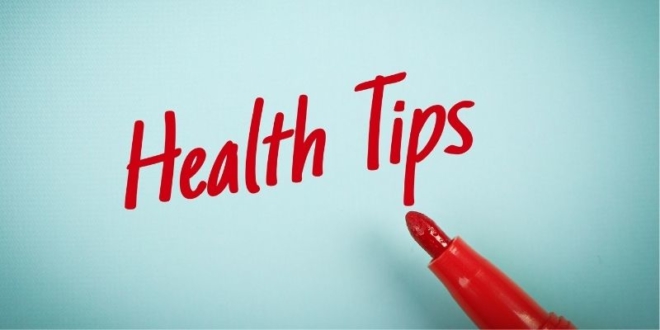
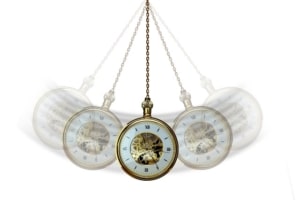






1 Comment
Pingback: 5 Ways to Boost Your Immune System Naturally - Healthy Lifestyle